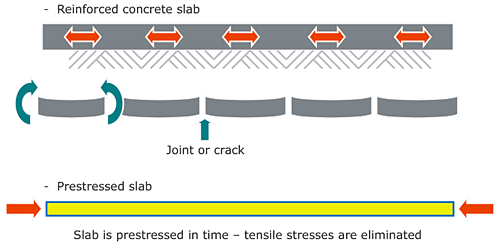The joint free post-tensioned slab on grade technology is useful mainly for medium to high load industrial floors and pavements in various storage buildings, airport terminal buildings, logistic parks, etc.
The greatest advantages of post-tensioned slabs on grade are the considerable reduction of the necessity for expansion joints being the most sensitive part of these structures and no cracks in concrete resulting in longer service life, enhanced quality and considerable lower costs of maintenance. The post-tensioned slab is thinner in comparison with the traditionally reinforced slabs and saves construction time, because smaller amounts of concrete are laid in larger areas per day, often round about 2,500 square metres.
The largest post-tensioned slab on grade made by VSL without expansion joints covered the area of 30,000 square metres.
VSL designes the post-tensioning of slabs to avoid tensile rupture of concrete under the most unfavourable combination of loads, i.e. without the use of rebar reinforcement and to introduce the compression into the structure in time before the generation of early shrinkage cracks starts. For these reasons, the concrete rupture through cracking is wholly prevented unlike with other crack control methods, which rely upon a higher amount of passive reinforcement only enabling to reduce the width of cracks according to a certain criterion.
Considering the many advantages of post-tensioned slabs on grade, particularly the superior quality, the investors repeatedly prioritise this technology.











